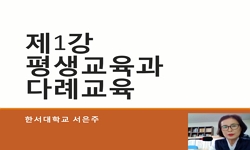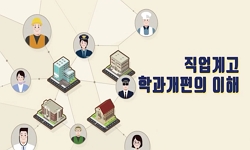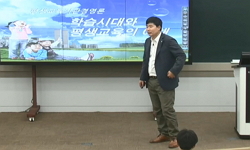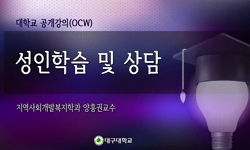While the increased opportunities for the education of women as well as social progress increased the married women's demand for employment Still, women's career interruption still happens caused by task performance in the life cycle of married women....
http://chineseinput.net/에서 pinyin(병음)방식으로 중국어를 변환할 수 있습니다.
변환된 중국어를 복사하여 사용하시면 됩니다.
- 中文 을 입력하시려면 zhongwen을 입력하시고 space를누르시면됩니다.
- 北京 을 입력하시려면 beijing을 입력하시고 space를 누르시면 됩니다.
https://www.riss.kr/link?id=T11823665
- 저자
-
발행사항
서울 : 한국방송통신대학교 평생대학원, 2009
-
학위논문사항
학위논문(석사) -- 한국방송통신대학교 평생대학원 , 평생교육학과 , 2009.8
-
발행연도
2009
-
작성언어
한국어
- 주제어
-
KDC
378.1378.1 판사항(4)
-
발행국(도시)
서울
-
기타서명
A Study on the State and Improvement Scheme of Vocational Education for Career-Interrupted Married Women : Centering on Vocational Centers in the Metropolitan Area
-
형태사항
viii, 95장 ; 26 cm.
- 소장기관
-
0
상세조회 -
0
다운로드
부가정보
다국어 초록 (Multilingual Abstract)
While the increased opportunities for the education of women as well as social progress increased the married women's demand for employment Still, women's career interruption still happens caused by task performance in the life cycle of married women. Long career interruption lowers married women's status in the labor market and makes worse imbalance between their demand for employment and employment conditions in the labor market, which seems to result from prejudices against them and from their lack of understanding of social changes. Therefore, systematic education ranging from basic training to cope with social change to
vocational education arc essential for career-interrupted women who want to be employed.
However, vocational education institutions for women cannot get a correct understanding of married women's demand for employment or that of the employment field going through various changes, thus failing to provide efficient vocational education. Since even national employment support projects for married women fail to fully consider their environment and characteristics and associations with employment, with significance given to quantitative increase rather than qualitative improvement, it is hard to expect long-term effectiveness from the projects. Such a phenomenon is more serious in Seoul and the Metropolitan area where disproportionate emphasis is laid on woman resources.
Prior studies dealt with causes of failing to activate employment of married women, mainly in terms of their will and attitude for getting a lob, child-rearing, maternity protection system, or policies. Considering universalization of the phenomenon of hiagher education among women, however, it will be necessary to compare differences by other employment factors, such as age, career, and the interruption period. So this study set the following questions to conduct a research.
First, how do employment motives among career-interrupted married women in the Metropolitan area differ by age, educational background, and the period of career interruption?
Second, how do views of vocational education among career-interrupted married women in the Metropolitan area differ by age, educational background, and the period of career interruption?
Third, how do views of employment projects among career-interrupted married women in the Metropolitan area differ by age, educational background, and the period of career interruption?
A sample was made of 220 married women participating in vocational education at such vocational education institutions for women in the Metropolitan area as the Seoul Women's Skills Development Institute, the Dongdaemun Woman Resources Development Center, and the Northern Gyeonggi Province Women Vision Center to conduct a survey. 179 valid ones were analyzed by using SPSS PC win 12.0, with the exception of 32 which were completed by unmarried women or contained insincere responses, consequently drawing the following conclusions.
First, composition and background properties of married women, who are trainees in vocational education institutions for women in the Metropolitan area, are as follows: As for the general composition of trainees in vocational education institutions for women in the Metropolitan area, more than 80% were in their thirties or forties; 79.4% were at a high education level as college graduates or higher; 80.4% had experience of being employed; and the majority of them had the interruption period of 3 to 5 years. This implies that higher-education married women in the middle class have their consciousness of employment spread positively and that it is necessary to make qualitative improvement in vocational education to meet their participation.
Second, there were statistically significant differences by education background and age in terms of their employment motives, criteria for selecting a job, obstacles of employment, and desired job. The criteria for selecting a job differed by employment motives: women in their thirties mentioned economic reasons, which reflects realistic matters, such as child-rearing or child education, and many of those in their forties and fifties suggested preparation for their old age. Most of the women in their twenties wanted professional work, those in their thirties or forties wanted educational service work, and those in their fifties wanted general service work. The higher educational level and the younger, the higher average monthly income they wanted. As for views of necessary support for employment, the majority of them suggested "diversification of vocational education programs," regardless of age, educational background, or interruption period, contrary to expectation. This demonstrates that married women urgently need development of various new job models and vocational education programs suitable for their age group.
Third, respondents' views of vocational education are as follows:
Most of the married women needed education for employment; as for a proper period of vocational education, women in their fifties or over suggested three months or less while those in their twenties suggested one year or less, which implied that the older women were, the earlier employment they wanted. In other words, older married women have greater anxiety about employment due to the age limits. They were visiting such educational institutions for women as women development centers and woman resources development centers to get vocational education; as for motives of participation in education, many of them expected getting a certificate through short-term education or possibilities of association with employment. Most of the married women in their forties or over who lacked information skills were getting information about employment through people around them, and were primarily visiting educational institutions for women to get vocational education because of lower educational expenses or expectation of association with employment. This implies that differentiated types of vocational education are necessary by age or career interruption period.
Fourth, respondents' views of nationally-supported employment projects are as follows;
As for experience of participating in nationally-supported employment support projects, the majority of them had no such experience, mostly because of insufficient institutional PRs. They still have low awareness of nationally-supported projects because most of the beneficiaries are restrictively those in their thirties to 49, probably because of lack of active PRs by educational institutions.
On the basis of the results, the following improvement direction can be suggested in terms of vocational education for career-interrupted married women.
First, it is necessary to provide more specifically segmented and diverse vocational education programs for career-interrupted married women according to various requirements and personal skills by regional conditions and their background properties.
Second, it is necessary to support service equipment of educational institutions for trainees.
Educational institutions for women mainly have trainees in their thirties to forties. The biggest burden against vocational education for them is child-care and child-rearing. It is therefore necessary for them to supplement service facilities for their trainees.
Third, it is necessary to develop effective, rational nationally-supported vocational education and projects in consideration of married women's circumstances.
Fourth, it is necessary to reinforce expertise of educators in order to improve vocational education institutions for married women.
In conclusion, as the aging phenomenon and low childbirth become serious social problems, it is first necessary to provide differentiated, rational support to meet local conditions by fully considering requirements and views of employment according to their background properties and age in order to settle career-interrupted married women's employment as a natural social phenomenon.
목차 (Table of Contents)
- Ⅰ. 서론 = 1
- 1. 연구의 필요성 및 목적 = 1
- 2. 연구 방법 = 4
- 3. 연구의 의의 및 제한점 = 5
- Ⅱ. 이론적 배경 = 7
- Ⅰ. 서론 = 1
- 1. 연구의 필요성 및 목적 = 1
- 2. 연구 방법 = 4
- 3. 연구의 의의 및 제한점 = 5
- Ⅱ. 이론적 배경 = 7
- 1. 경력단절의 의미와 기혼여성의 취업요구 = 7
- 2. 경력단절 기혼여성을 위한 취업 교육 현황 = 18
- Ⅲ. 연구 설계 = 33
- 1. 연구 대상 = 33
- 2. 연구 도구 = 33
- 3. 자료처리방법 = 35
- Ⅳ. 결과 분석 및 논의 = 36
- 1. 결과 분석 = 36
- 2. 논의 = 70
- Ⅴ. 요약, 결론 및 제언 = 74
- 1. 요약 및 결론 = 74
- 2. 제언 = 76
- 참고문헌 = 80
- 부록 = 83
- ABSTRACT = 90












